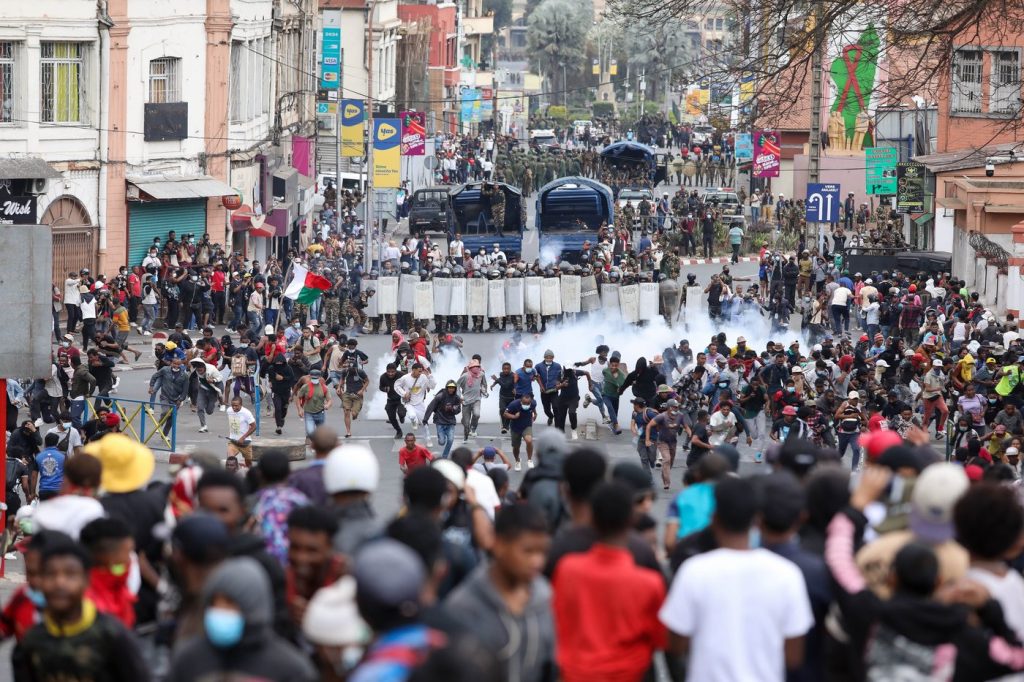World
Madagascar Protests Escalate as Gen Z Demands President’s Resignation

Protests in Madagascar escalated on Thursday as approximately 1,000 demonstrators marched through the capital, Antananarivo, demanding the resignation of President Andry Rajoelina. Clashes erupted between protesters and police, who employed tear gas and stun grenades to disperse the crowds. This unrest marks the third consecutive week of significant demonstrations in the Indian Ocean island nation, representing the most intense civil discontent in years.
Protests Sparked by Multiple Grievances
Initially ignited by widespread water and power outages, the protests have expanded to include accusations of corruption and nepotism within the government. As tensions mounted, the United Nations reported that at least 22 people have died in the protests, a figure disputed by the government. The protests have been organized by a youth-led group called Gen Z Madagascar, which has drawn inspiration from recent uprisings in other nations, including Nepal and Sri Lanka.
In a bid to quell the unrest, President Rajoelina, who was re-elected in 2023 after a boycott by opposition parties, dismissed his entire Cabinet. Despite this action, the young protesters rejected an invitation for dialogue with Rajoelina, indicating their determination for more substantial change.
During the clashes, which were concentrated in the Anosy and Mahamasina districts, protesters barricaded streets using rocks and burning tires. Police restricted vehicle access to key areas, including Democracy Square in Ambohijatovo, as they attempted to maintain order. The atmosphere remained tense, with reports of ongoing confrontations and instances of looting.
Historical Context and Ongoing Challenges
Madagascar, home to around 31 million people, has a history of political upheaval, having seen multiple leaders ousted since gaining independence from France in 1960. The country grapples with severe poverty, with around 80% of the population affected, according to the World Bank. As the protests continue, images of a pirate skull and crossbones have emerged as a symbol of the movement, echoing similar imagery from international protests.
As police patrol the streets of Antananarivo in armored vehicles, the situation remains fluid. The government’s ability to address the underlying issues driving the protests will be crucial in determining whether the unrest will subside or escalate further in the coming days.
-

 Science2 months ago
Science2 months agoToyoake City Proposes Daily Two-Hour Smartphone Use Limit
-

 Health2 months ago
Health2 months agoB.C. Review Reveals Urgent Need for Rare-Disease Drug Reforms
-

 Top Stories2 months ago
Top Stories2 months agoPedestrian Fatally Injured in Esquimalt Collision on August 14
-

 Technology2 months ago
Technology2 months agoDark Adventure Game “Bye Sweet Carole” Set for October Release
-

 World2 months ago
World2 months agoJimmy Lai’s Defense Challenges Charges Under National Security Law
-

 Technology2 months ago
Technology2 months agoKonami Revives Iconic Metal Gear Solid Delta Ahead of Release
-

 Technology2 months ago
Technology2 months agoSnapmaker U1 Color 3D Printer Redefines Speed and Sustainability
-

 Technology2 months ago
Technology2 months agoAION Folding Knife: Redefining EDC Design with Premium Materials
-

 Technology2 months ago
Technology2 months agoSolve Today’s Wordle Challenge: Hints and Answer for August 19
-

 Business2 months ago
Business2 months agoGordon Murray Automotive Unveils S1 LM and Le Mans GTR at Monterey
-

 Lifestyle2 months ago
Lifestyle2 months agoVictoria’s Pop-Up Shop Shines Light on B.C.’s Wolf Cull
-

 Technology2 months ago
Technology2 months agoApple Expands Self-Service Repair Program to Canada









